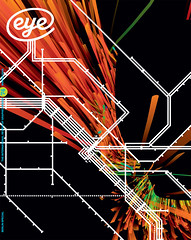Winter 2009
The farewell tour syndrome
Emigre No.70
The Look Back Issue<br>Gingko Press £45 / $49.95<br>Earlier this year I was researching past issues of Emigre magazine for an exhibition project and found myself at the website of New York’s Museum of Modern Art, checking issue numbers and titles against those in their collection. I wasn’t surprised to find the magazine there – the acquisition of the full run in 2006 was if anything overdue – yet I was struck that my incomplete and slightly tattered set of back issues had been superseded by an art museum’s holdings. The letterforms and layouts that shaped my personal graphic design conscience had become the pillars of the discipline’s history. Apparently MoMA’s endorsement had a similar effect on Emigre’s editor Rudy VanderLans. For him, in combination with the title’s 25th anniversary, it made the call of posterity irresistible.
Several stories run through Emigre’s ‘Look Back Issue’. First there is the rapid, computer-driven evolution of the magazine’s production described by VanderLans in the introduction. Then there are the trials and triumphs of magazine-making also seen through the eyes of the editor in a series of excerpts from the previously published Emigre No. 69 ‘The Final Issue’ – could Mr. VanderLans be running the risk of the everlasting ‘Farewell Tour’? Meanwhile, there are the developments in VanderLans’ graphic style over the past quarter century and the blossoming of his partner Zuzana Licko’s brilliant type design career. Finally, and perhaps what Emigre magazine is best remembered for, there are the flames of the early 1990s legibility wars and the uncertain smoulder of their anti-consumerist aftermath.
Leafing through the book delivered me directly to the extraordinary period when Licko’s apparently innocuous line that ‘people read best what they read most’ was met by the accusation that her work was ‘garbage’. Although Licko is the less outspoken of the partnership, it was her typefaces that carried Emigre’s message beyond its pages and attracted the wrath of design conservatives such as Massimo Vignelli. Scrupulously recreating magazine pages, where possible from the original digital files, VanderLans recaptures their powerful combination of graphic form and argument and, although some of the feel particularly of the larger issues has been lost, his skilful edit of 69 publications into just over 500 pages delivers the pace and intensity of the debate.
If I have a quibble, it is with the amount of space given over to the reprint of VanderLans’ ‘Final Issue’ reminiscences. It is not that they are uninteresting, but they have already been published and I would have preferred those pages be filled with more of the wonders of the previous 68 numbers. That said, Emigre is Licko’s and VanderLans’ story to tell how they wish, and, for those who want to construct another account of the magazine, there is always the option of a trip to MoMA’s archive.
First published in Eye no. 74 vol. 19 2009
Eye is the world’s most beautiful and collectable graphic design journal, published quarterly for professional designers, students and anyone interested in critical, informed writing about graphic design and visual culture. It is available from all good design bookshops and online at the Eye shop, where you can buy subscriptions and single issues.

